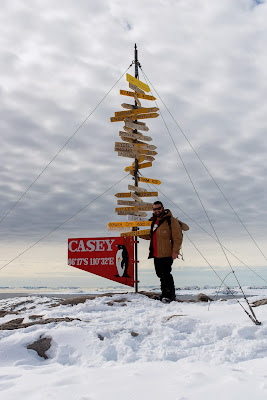Well, lets start off
the latest happenings on a positive note!
Field training..
Every wintering
expeditioner has to complete multiple forms of field training once on
station. There is Survival training which is an overnight camp in an
emergency shelter called a 'bivvy bag'. Field travel training which
involves multiple days and nights out in the field navigating with
maps, compasses and GPS (kind of orienteering), some do 48hr
familiarisation training if they aren’t already familiar with this
particular location then finally we do numerous SAR (Search and
Rescue) training exercises in case of an unfortunate incident out in
the field.
Field travel training
this year involved Quad biking around the many Fjords of the
Vestfolds, staying at Platcha hut at the base of the Antarctic
Plateau, setting up a field camp and staying in a Polar pyramid tent
and finally a sightseeing and navigation tour through 'Iceberg
alley'. It was an amazing trip, we experienced most of the weather
Antarctica has to offer, from icy cold winds and blowing snow to
scorching sunshine that will burn any exposed piece of skin in the
blink of an eye. Check it...
 |
| Platcha at the base of the Plateau |
 |
| Fjords, Vestfolds and the Plateau |
 |
| I wish I knew more about rocks... |
 |
| Tryne Islands and Iceberg Alley |
 |
| Anthea deliciously explaining how Crevasses form |
 |
| Not a bad backdrop for some training! |
Now for the not so great stuff...
As some of you may have
heard, we had an incident with one of our helicopters recently. We
had 2x choppers out in the field checking out a rarely seen Emperor
Penguin colony out past the Amery ice shelf. On the return voyage
they experienced white-out conditions which is an occasional problem
down here and also a very disorientating effect where you can lose
sight of the horizon and all surface definition.
One chopper clipped the
ground while attempting to move out of the 'white-out' area. The
other Heli landed nearby and proceeded to assist the passengers of
the downed aircraft. Miraculously they were all breathing and were
immediately stabilised by the second crew.
Meanwhile we received
the call on station and proceeded to make plans for a rescue. Luckily
we had 2x Canadian Kenn Borek crews stationed here with a Twin Otter
and Basler DC3 fixed-wing aircraft. Most of the rescue can be read
about here:
http://www.smh.com.au/national/antarctic-helicopter-crash-survivors-had-luck-on-side-20131206-2ywom.html
As expected an incident
like this can affect the station greatly, which it did and has. From
the outside it may look like these people are just work colleagues
but in reality we had been through quite a lot together from
training, living on the ship and at station and we knew every member
on a quite personal level.
I also had a
challenging and unexpected role to play as I am part of the Lay
Surgical team with the job of assisting our Doctor with incidents
such as these. I wont go into detail for obvious reasons but this was
something I have never experienced before but I am very proud to be a
part of. I was also asked to help monitor the patients during the
medivac to Casey station where they were picked up by our A319 Airbus
to be returned to Hobart hospital.
It was nice to visit one of our
other stations for a few days but it would have been better to be under
different circumstances...
 |
| The Airbus at Wilkins awaiting our injured expeditioners. |
 |
| They have some impressive machinery up there! |
 |
| Priscilla, Queen of the snow! |
 |
| Our trusty steed. The DC3. |
 |
| From any angle its a beautiful plane. |
 |
| First class only. (on the way home) |
 |
| Casey Station. |
Safely home now (Davis)
Talk again soon!



Hi Corey,
ReplyDeleteThough it's somewhat difficult to tell from the photo and not hold it in my hand I'd say that's a pretty classic metamorphic rock (cooked deep underground) called a gneiss. The banding is formed by shearing deep underground over geological time (many many millions of years). Shearing is kind of like pushing a deck of cards from the bottom on one side and the top on the other so the cards slide over each other, this stretches the rock when it's in a kind of plastic state due to the pressure and heat down there, thus bands form. I'd take a stab and say that the rock is Archaean aged, somewhere around 2500 - 3000 million years old (2.5 - 3 billion). So pretty damn old.. Most of Antarctica (theoretically) is ancient cratonic rock, like in Western Australia (Yilgarn and Pilbara cratons) which you may have heard of, so this type of rock would be pretty common there, along with other metamorphic rocks. Antarctica was about 100 million years ago still completely attached to the southern margin of Australia and only completely separated about 30 million years ago, so the Geology has similarities to the western 2/3 of the country. Would like to head down to Antarctica, and not for lack of trying, getting a job down there is tough with my skill set. Stay well and great blog.
cheers,
J.